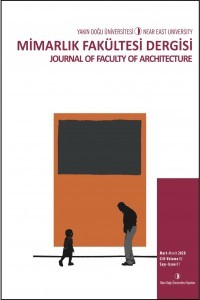Feodalizm Dönemi Azerbaycan Mimarisinde Renk ve Işık
ışık, renk, Azerbaycan mimarisi, seramik, dekorasyon
Color and light in the Azerbaijan architecture during the feudalism period
light, color, Azerbaijan architecture, ceramic tiles, decoration,
___
- Aliyeva K. (1999) The Tabriz Carpet School of the 16th-17th Centuries. Elm, Baku. (Aliyeva K. (1999) Tebrizskaya kovrovaya shkola XVI-XVII vekov. Elm, Baku.)
- Efendi R. (1984) The Azerbaijan Folk Art. Light, Baku. (EfendiI R. (1984) Azərbaycan Xalq Sənəti. İşıq, Bakı.)
- Friling G., Auer K. (1973) A Man - a Colour - a Space. An Applied Colour Psychology. Stroyizdat, M. (Friling G.,Auer K.(1973) Chelovek - tsvet- prostranstvo. Prikladnaya tsvetopsihologiya. Stroyizdat, M.)
- Huseynov I., History of Azerbaijan in Two Volumes. (1958) The Publishing House of the Academy of Sciences of the Azerbaijan SSR. 1958, v.1. Baku. (Istoriya Azerbaydjana v 2-h tomah. (1958) Izdatelstvo Akademii Nauk Azerbaidjanskoy SSR, , t.1.Baku.)
- Kajar Ch.(2003) Art of Azerbaijan. Middle Ages. Published with suppot of the Culture Fund of Azerbaijan, Baku. (Kajar Ch.(2003) Iskusstvo Azerbaydjana. Srednie veka. Culture Fund of Azerbaijan, Baku.)
- Keler V., Lukhardt V. (1961) Light in Architecture. Light and Colour as Meanings of Architectural Expressiveness. Gosstroyizdat, M. (Keler V., Lukhardt V. (1961) Svet v architekture. Svet i cvet kak sredstva architekturnoy virazitelnosti. Gosstroyizdat, M.)
- Starodub T.H.(2013) A Secret of uniqueness.-Azerbaijani carpets,Vol.3№9 2013, pp.108-117.( Starodub T.H.(2013) Sekret nepovtorimosti.- Azerbaijan halchalari, Jild 3 №9 2013)
- Miller Y. (1972) The Artistic ceramics of Turkey.Avrora,L.( Miller Yu.(1972) Khudojestvennaya keramika Turcii., Avrora, L.)
- Salamzade A.R., Mammad-zade K. M. (1987) The Monuments of Architecture of Sheki.Elm, Baku. (Ə.R.Salamzade, K.M.Mammad-zade.(1987) Şəkinin memarlıq abidələri. Elm,Bakı.)
- Soustiel L.(2000) Osmanlı Seramiklerinin Görkemi . XVI-XIX.Yuzyıl. Suna-İnan kıraç ve Sadberk Hanım Müzesi koleksiyonlarından. Katalog. İnstitut de France. Jacqemart –Andrè Müzesi. 1 Nisan – 2 Temmuz, Paris.
- Usseynov M., Bretanitskiy L., Salamzade A. (1963) History of Architecture of Azerbaijan. The State Publishing House for Literature on Construction, Architecture and Constructive Materials.Moscow. (M.Usseynov, L.Bretanitskiy, A.Salamzade.(1963) Istotiya arhitekturi Azerbaijana.Gosudarstvennoe Izdatelstvo literaturi po stroitelstvu, arhitekture i stroitelnim materialam. M.)
- Vipper B. R. (1985) Introduction intoa historical study of art. Fine Arts, M. (Vipper B.R. (1985) (Vvedeniye v istoricheskoe izuchenie iskusstva.Izobrazitelnoe iskusstvo, M.)
- ISSN: 2687-2757
- Başlangıç: 2019
- Yayıncı: Yakın Doğu Üniversitesi
Dostluğa ve Alçakgönüllülüğe Övgü ‘Mimarlığı Öncesiyle Kuşatmak’
Feodalizm Dönemi Azerbaycan Mimarisinde Renk ve Işık
Aysel MİRKASİMOVA, Rana AMRAHOVA
Hande Sanem ÇINAR, Nilüfer Kart AKTAŞ
Karizmatik Bir Figür olarak “Starchitect”
Sahiciliğin Sadeliği: Ziya Tanalı’nın Etiği ve Japon Estetiği
